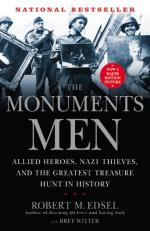
|
| Name: _________________________ | Period: ___________________ |
This test consists of 5 multiple choice questions, 5 short answer questions, and 10 short essay questions.
Multiple Choice Questions
1. The Hungarian crown jewels were discovered in an oil barrel sunk in marshland near what village in Bavaria?
(a) Trier.
(b) Mattsee.
(c) Asnières.
(d) Vienna.
2. When was Hitler’s Nero Decree issued?
(a) March 23, 1945.
(b) April 16, 1945.
(c) September 17, 1940.
(d) March 19, 1945.
3. When was the city of Munich founded?
(a) 1265.
(b) 1325.
(c) 1158.
(d) 1495.
4. What was the official title of Hitler’s Nero Decree?
(a) Demolitions on Reich Territory Decree.
(b) Destruction of Impasse Decree.
(c) Interruption of Passage Decree.
(d) Third Reich Submergence Decree.
5. What was the nickname of the Third Infantry Division of the U.S. Seventh Army?
(a) “The Albatross of the West.”
(b) “The Rough Riders.”
(c) “The Rock of the Marne.”
(d) “The Rolling Stone.”
Short Answer Questions
1. Who was Martin Bormann’s secretary in the bunker with Hitler and thus privy to most communiqués in the Third Reich, according to the author in Part V: “The Aftermath,” Chapter 51?
2. How long was the memo that Albert Speer composed on the apocalyptic effects of Hitler’s planned “scorched earth” policy?
3. Whose name was on the casket that was adorned with a wreath and red ribbons in the mine at Bernterode?
4. Who was the head of the Mineralogical Department of the Natural History Museum, Vienna that supposedly sent a message alerting Major Pearson to the hidden treasures at Altaussee?
5. Who was the commander of the Third Infantry Division of the U.S. Seventh Army?
Short Essay Questions
1. What led to the destruction of the Friedrichshain tower and many of the relics inside on May 1, 1945?
2. What did Captain Robert Posey and Private Lincoln Kirstein find in Trier, Germany, in March of 1945?
3. What does the author write of Harry Ettlinger’s meeting with Heinrich Hoffman in Part V: “The Aftermath,” Chapter 53?
4. Whom was Second Lieutenant James J. Rorimer upset that he was unable to interrogate as he approached Neuschwanstein?
5. How and when did Adolf Hitler die? What did Hitler remark in his will regarding his art collection?
6. Where were Captain Robert Posey and Private Lincoln Kirstein assigned in April of 1945? What did they discover in this location?
7. How does the author describe the work of the Monuments Men following the end of the war in Part V: “The Aftermath,” Chapter 53?
8. What did Second Lieutenant James J. Rorimer find in Neuschwanstein on his visit in early May of 1945?
9. Whom does Robert Edsel credit as the “true hero of Altaussee” in Part V: “The Aftermath”? Why?
10. When did Captain Robert Posey and Private First Class Lincoln Kirstein arrive in Altaussee? What did they discover there?
|
This section contains 874 words (approx. 3 pages at 300 words per page) |

|




